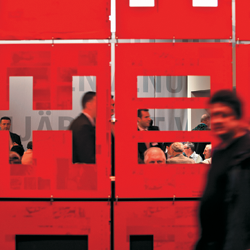 itting a square peg into a round hole is always a tricky endeavor, but when no round peg exists, sometimes you have to make do with what you have on hand. itting a square peg into a round hole is always a tricky endeavor, but when no round peg exists, sometimes you have to make do with what you have on hand.
This is the challenge faced by exhibitors and suppliers in the trade show industry, as industry-specific environmental standards don't yet exist. Going Green today means either trying to figure out what is or isn't Green on your own, or attempting to adapt Green standards from other industries to the wacky world of trade shows. Considering 62 percent of exhibitors have a high interest in going Green, and the same percentage see the interest in Green options increasing in the coming year, according "An Inconvenient Booth," it should come as no surprise that exhibitors and suppliers alike are eager to find some way to validate their eco-friendly efforts.
"It's important to acknowledge where we're at as an industry," says Anah Corley, vice president for business development at Stetson Convention Services Inc. Corley serves two roles in a movement to roll out Green exhibiting standards in the next six to eight months, working as co-chair of the Exhibit Designers and Producers Association (EDPA) Sustainable Exhibit Leadership Committee and as a member of the executive task force reporting directly to the Accepted Practices Exchange (APEX) panel that is working in conjunction with the American Society for Testing and Materials (ASTM) and the Convention Industry Council (CIC) to develop the standards. In Corley's words, without standards specific to our industry, "everyone is just throwing darts at the board right now."
Steve Deckel, design director at Deckel & Moneypenny Exhibits in Louisville, KY, echoes Corley's sentiment. "Is bamboo Green or isn't it? Ask two people and you're likely to get two different answers," Deckel says. "Having some sort of industry standard takes the guesswork out of it. Then you're not just trusting that your supplier is telling you the truth, as you can actually look to the standards and see whether or not the exhibit he's telling you is Green meets the requirements. Today, in lieu of actual guidelines, everyone is kind of making up the rules as they go along."
What's worse, without commonly accepted standards, any exhibitor can slap up a placard in its booth or put a mention in its press kit claiming that its exhibit is a Green property. This overzealous attempt to reap the benefits of Green without taking the necessary steps to go Green in earnest has already been documented in the consumer-products world.
In its "The Six Sins of Greenwashing" study of 1,018 consumer products touting a total of 1,753 environmental claims, TerraChoice Environmental Marketing Inc., an environmental-marketing company in Philadelphia, concluded that all but one product made false or misleading claims. And those little Green lies do more than damage the reputations of companies who knowingly or unknowingly tell them - they also undermine the legitimate Green movement by flooding the marketplace with eco imposters who say one thing and do another, making legit Green claims that much harder for consumers to swallow.
Finding the Best Fit
In lieu of industry-specific enironmental standards, many exhibit managers and designers are turning to the Leadership in Energy and Environmental Design (LEED) standards. Developed by the U.S. Green Building Council (USGBC) to help guide builders in developing practices and materials for commercial and residential properties that are friendlier to the environment, LEED for Existing Buildings (LEED EB) is commonly accepted as the LEED rating systems most applicable to the exhibit industry. LEED EB ranks buildings on a 100-point scale in five categories including Sustainable Sites, Water Efficiency, Energy and Atmosphere, Materials and Resources, and Indoor Environmental Quality. Ten bonus points are available to builders in two bonus categories - Innovation in Operation and Regional Bonus Credits - for a total of 110 points.
Applying that point system, the USGBC certifies buildings for the construction industry, serving as a third party outside the commercial realm of builders and suppliers. There are four levels of recognition including basic certification plus silver-, gold-, and platinum-level certification.
In addition to standards for Green materials and practices, LEED EB comes with a score card that can be downloaded from the USGBC Web site. "Exhibit designers can essentially use the LEED EB score card as a checklist," Corley says.
But because the LEED standards - even LEED EB - are still an imperfect fit for the exhibit industry, exhibit designers have to use them as a loose guideline instead of a straight road toward Green. "It's a bit of jerry-rigging. What we've had to do is a little picking and choosing on what makes sense," says Gary Survis, managing partner of Go Green Displays LLC of Woodbridge, NJ. For Survis, the LEED EB categories he finds most helpful in guiding exhibit-related decisions include Indoor Environmental Quality, Energy and Atmosphere, and Materials and Resources.
While those topics might cover nonapplicable items such as tobacco-smoke control, they also provide standards for the use of recyclable and durable materials; the reduction of harmful volatile organic compounds (VOCs); and the use of energy-efficient operating strategies.
For Corley, though, the takeaway from LEED is even simpler. "It provides
a framework that encourages three core tenants: Reduce consumption, reuse as much as possible, and recycle. We're in a very waste-producing industry, and the reality is that reducing our environmental impact is the right thing to do."
But while LEED can serve as a great guiding principle, Survis cautions against over-promoting a properties' LEED credentials. "There are folks out there branding their booths with LEED and calling their exhibits LEED certified," Survis says. "But there is no LEED certification for exhibits. We can hire a LEED-certified designer. We can use LEED-certified materials. But we've just bastardized it at this point. We're trying mightily to establish metrics in this business, but ultimately we need to have a certification standard for Green that is specific to exhibits."
That desire for standards is behind the EDPA's ongoing efforts. Eventually, the standards developed by its Sustainable Exhibit Leadership Committee could become the basis of a certification program that would be overseen by a neutral third party - a move the EDPA hopes will eliminate bias and subjectivity from the process. With that in mind, Corley and the EDPA committee are working with the ASTM, an independent organization that develops standards for a variety of industries.
Survis is optimistic that the implementation of industry-specific Green standards will change how exhibit designers do business for the better. "We're going to start moving down a path where Green options are just part of how we do business," he says.
But before those standards are developed and adopted, there is a lot of work to be done. Committees covering several categories - including materials, energy, and transportation - need to develop industry-specific standards in their areas of expertise, then share those results with the overall committee. And those initial results will need to be examined and re-examined. "This is not going to be perfect the first time out," Corley says. "It will go through a lot of vetting. But getting something on paper is the first step to completing this project and establishing the environmental standards this industry needs." e
|




 itting a square peg into a round hole is always a tricky endeavor, but when no round peg exists, sometimes you have to make do with what you have on hand.
itting a square peg into a round hole is always a tricky endeavor, but when no round peg exists, sometimes you have to make do with what you have on hand. 




